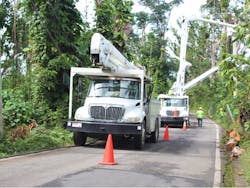Puerto Rico’s first intermunicipal microgrid — one that provides power to multiple towns and residents — is now under development by California-based microgrid developer XENDEE and the Idaho National Laboratory (INL).
Called Microrred de la Montaña (Microgrid of the Mountain), the net-zero community microgrid will be governed by the island’s first electric cooperative, Cooperativa Hidroeléctrica de la Montaña (Mountain Hydroelectric Cooperative).
“By using this new resilient energy system, Puerto Rico’s mountain regions can offer greater stability for businesses and the community while also mitigating the consequences of the next major climate event,” said C.P. Smith, executive director of the Cooperativa Hidroeléctrica de la Montaña.
Microgrid of the Mountain will provide power to the 90,000 residents of the towns of Adjuntas, Jayuya, Lares and Utuado. The project team expects that the solar plus storage community microgrid will cut energy costs for the community by at least 20%. It will also be capable of integrating existing hydroelectric technology, which can boost those savings to as much as 60%.
Timothy McJunkin, technical director of the NZM program at INL, said, “This project stands out as a unique opportunity to showcase the integration of multiple non-greenhouse emitting energy sources to increase reliability and resilience.”
Ultimately, the microgrid will be able to support even greater hydroelectric capacity. Upgrades to the island’s hydroelectric power plants could result in the microgrid being able to output 50 MW of electricity. This would allow the cooperative to sell energy to the rest of the island.
The overall goal of the microgrid is to provide Cooperativa Hidroeléctrica de la Montaña with “a series of reliable, financially viable investment strategies that can be used to easily compare major design decisions like making hydroelectric upgrades or distributing technologies across different communities,” according to Michael Stadler, CTO and co-founder of XENDEE.
“This added level of security and local control can immediately impact resilience and sustainability in the region while also enticing investment from both the public and private sector with reliable clean energy at attractive rates,” Smith added.
Puerto Rico’s energy infrastructure issues are well known. Ravaged by tropical storms, the island is increasingly turning to alternative energy sources to provide more resilience and reliability. Other towns in Puerto Rico, such as Maricao, are investing in microgrids to ensure a reliable stream of electricity to power critical infrastructure.
Track news about microgrid development in Puerto Rico. Subscribe to the free Microgrid Knowledge Newsletter.








